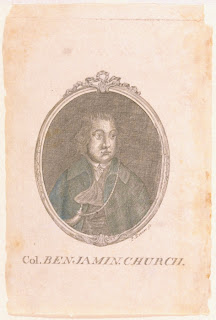My post yesterday has generated some discussion as to just how potent a drink the "Stone Fence" was in colonial America.
The rum so widely consumed throughout colonial America was a cheap dark rum made from poor quality molasses, not to be confused with the "refined" rums one encounters today. In 1770, there were approximately 140 rum distilleries throughout the thirteen colonies producing about 4.8 million gallons of rum annually. Another 3.78 million gallons were being imported from the Caribbean. One curious fact about the rum produced in the Caribbean is that because of the high temperatures, rum ages at approximately three times the rate of Scotch. Thus a seven year Caribbean rum is aged to the same state as a 21 year old Scotch.The Caribbean imported rum was considered to be of a higher quality than a domestic distilled rum.
There can be no certainty as to the "proof" or alcohol content of Caribbean and colonial rum such as that consumed by the Green Mountain Boys but it was most likely close to 90% alcohol or higher. Hard cider, such as that fermented by colonial New Englanders, contained approximately 5 to 7% alcohol so "cutting" the rum with it didn't dilute the alcohol content by much. As a comparison, my favorite 12 year old Macallan has 40% alcohol. I don't think I could keep up with the Green Mountain Boys for very long.
There are some claims that New England distilleries produced a "high quality" rum and several micro distilleries have opened in New England claiming to duplicating colonial era rum. I have serious reservations about their claims and doubt that a modern distillery could sell its product to a discerning modern public without using much higher quality ingredients than those available to New England distillers.
I have visited the A. Smith Bowman Distillery in Fredericksburg, VA which makes, among other products, a colonial era dark Caribbean rum; however, this rum is distilled in the Caribbean and bottled in Virginia. The distiller insists that is distilled, aged, and blended much as it was in the colonial era.
George Washington was a great fan of Barbados rum and agreed with the common belief at the time that Barbados rum was richer and more complex than all the other rums.
Washington, at the time of his death, was a very successful rye whiskey distiller. In 1797, Washington's Scots farm manager, James Anderson, encouraged him to build a whiskey distillery adjacent to his gristmill. The distillery was the largest in America, producing 11,000 gallons of whiskey in 1799, making it one of the most successful economic enterprises at Mount Vernon.
Recently Mount Vernon reconstructed Washington's distillery and it is available for touring. I went on the tour when it opened several years ago and, quite frankly, was underwhelmed.
On November 28th, and for one day only, Mount Vernon is selling bottles of a limited edition "George Washington Unaged Rye Whiskey" made at Mount Vernon's reconstructed distillery from the original recipe at $95 a bottle.
The rum so widely consumed throughout colonial America was a cheap dark rum made from poor quality molasses, not to be confused with the "refined" rums one encounters today. In 1770, there were approximately 140 rum distilleries throughout the thirteen colonies producing about 4.8 million gallons of rum annually. Another 3.78 million gallons were being imported from the Caribbean. One curious fact about the rum produced in the Caribbean is that because of the high temperatures, rum ages at approximately three times the rate of Scotch. Thus a seven year Caribbean rum is aged to the same state as a 21 year old Scotch.The Caribbean imported rum was considered to be of a higher quality than a domestic distilled rum.
There can be no certainty as to the "proof" or alcohol content of Caribbean and colonial rum such as that consumed by the Green Mountain Boys but it was most likely close to 90% alcohol or higher. Hard cider, such as that fermented by colonial New Englanders, contained approximately 5 to 7% alcohol so "cutting" the rum with it didn't dilute the alcohol content by much. As a comparison, my favorite 12 year old Macallan has 40% alcohol. I don't think I could keep up with the Green Mountain Boys for very long.
There are some claims that New England distilleries produced a "high quality" rum and several micro distilleries have opened in New England claiming to duplicating colonial era rum. I have serious reservations about their claims and doubt that a modern distillery could sell its product to a discerning modern public without using much higher quality ingredients than those available to New England distillers.
I have visited the A. Smith Bowman Distillery in Fredericksburg, VA which makes, among other products, a colonial era dark Caribbean rum; however, this rum is distilled in the Caribbean and bottled in Virginia. The distiller insists that is distilled, aged, and blended much as it was in the colonial era.
George Washington was a great fan of Barbados rum and agreed with the common belief at the time that Barbados rum was richer and more complex than all the other rums.
Washington, at the time of his death, was a very successful rye whiskey distiller. In 1797, Washington's Scots farm manager, James Anderson, encouraged him to build a whiskey distillery adjacent to his gristmill. The distillery was the largest in America, producing 11,000 gallons of whiskey in 1799, making it one of the most successful economic enterprises at Mount Vernon.
Recently Mount Vernon reconstructed Washington's distillery and it is available for touring. I went on the tour when it opened several years ago and, quite frankly, was underwhelmed.
On November 28th, and for one day only, Mount Vernon is selling bottles of a limited edition "George Washington Unaged Rye Whiskey" made at Mount Vernon's reconstructed distillery from the original recipe at $95 a bottle.
 |
| Mount Vernon Distillery |

















